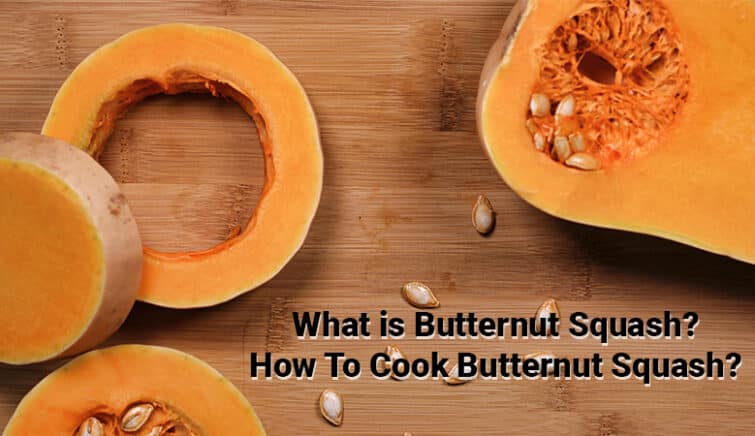Introduction
Let’s learn how to cook butternut squash and what essential ingredients you need to make a delicious cucurbita moschata recipe! If you’re a beginner or a pro, this cooking guide helps you a lot!
Well, if you are already a pro, then you will check this guide to see if we have given any recipe formulas and you can check other important information about it.
The nutty and sweet flavor of this winter squash is delicious in both savory and sweet recipes. You can roast the butternut squash, caramelize it in a variety of flavors, or cook it in a pressure cooker if you’re short on time.
What is Butternut Squash?
Butternut squash is a type of winter squash known for its nutty flavor reminiscent of pumpkin. It also offers an ideal Vitamin A, fiber, and potassium supply. This fruit comes with a nutty flavor, which is almost similar to the taste of pumpkin, and that’s why sometimes it’s also mistaken as a pumpkin. Farmers usually cultivate butternuts on a vine, another distinctive feature.
It has an orange fleshy pulp with tan-yellow skin and a division of seeds that bloom in the end. Moreover, you can store it for two to three months if prepared well. Since it’s a winter squash, it’s generally harvested in the fall season, yet it’s available all year round.
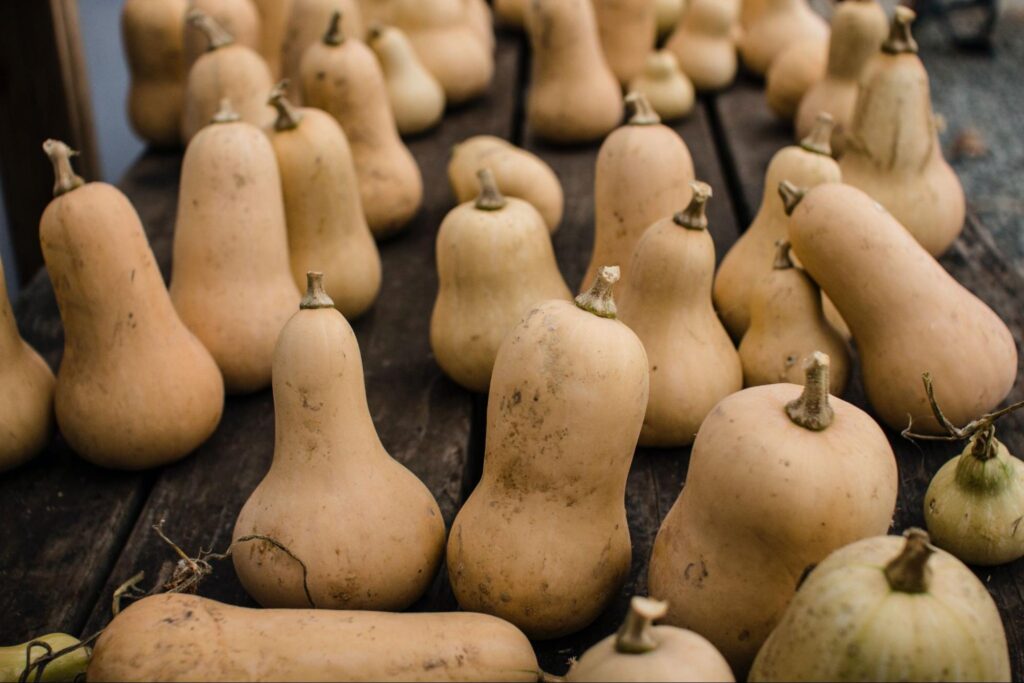
Image Source: Unsplash
The nutritional benefits of winter squash make it a versatile and valuable addition to your diet. Packed with nutrients that support blood pressure regulation, aid digestion, and promote healthy hair and skin, incorporating winter squash into your meals can have a positive impact on your overall well-being. It can be roasted or cubed to serve as a side dish or can be added to a leafy green salad.
After making butternut squash puree, it can also be used in soups, baked into bread, or to top or fill the pasta. Additionally, when baking with winter squash, you may discover its delightful ability to impart a subtle sweetness and moist texture to cakes, breads, and muffins, making it a delightful ingredient for both savory and sweet recipes.
Different Names of Butternut Squash
The butternut squash, a versatile and popular vegetable, goes by various names depending on the region. One of its most common monikers is winter squash. In New Zealand and Australia, it is often referred to as butternut pumpkin or gramma. These alternate names reflect the diverse ways in which this delicious and nutritious squash is recognized and incorporated into different culinary traditions across the globe.
Merits & Demerits Of Butternut Squash
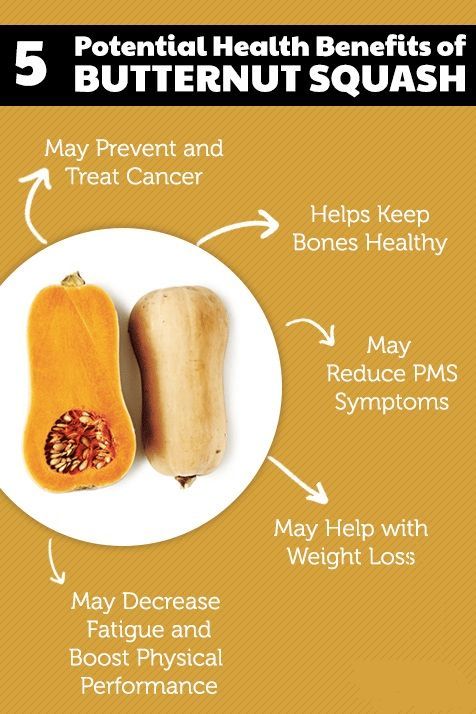
Image Source: Pinterest
Let’s first learn about the health benefits of cucurbita moschata before learning how to cook butternut squash!
Health Benefits Of Butternut Squash
1 – Good source of hydration
One serving of bell-shaped squash is roughly 87% water, which will keep you at an ideal dosage of hydration.
2 – Great for eyes
Winter squash is a highly beneficial source of zeaxanthin and lutein, two essential nutrients commonly present in various vegetables, yellow fruits, and eggs. These compounds are known for their high beta-carotene and Vitamin A levels, which play a crucial role in maintaining optimal eye health. Consistent consumption of winter squash can significantly contribute to protecting your eyes from the harmful effects of UV rays, making it a valuable addition to a healthy diet focused on eye care
3 – Boosts immunity power
Like other orange-colored fruits and vegetables, cucurbita moschata contains alpha-carotene and beta-carotene. Your expert body mechanism transforms these pigments into Vitamin A, a necessary vitamin to strengthen your immunity.
Drawbacks Of Butternut Squash
A. Rich in potassium
Although this is a healthy pick, it contains a high potassium content, too, which makes it a little infeasible when your potassium levels are imbalanced as it shouldn’t be too high in one’s body.
B. It may not be ideal for kidney patients
People with kidney problems should take care when consuming potassium in large quantities. Since it’s a potassium-packed fruit, your kidney may be unable to remove excess of it, especially when you’re already suffering from kidney disease.
Pumpkin Vs. Butternut Squash: Are They Similar?

Image Source: Seasonal Eating
Although it’s called butternut pumpkin, there is still a clear line of difference between a pumpkin and butternut squash.
Pumpkin’s role?
Pumpkin helps strengthen the immune system and is rich in vitamins A, C, and potassium. It also helps your muscles function smoothly. Pumpkin is also rich in Vitamin B6, which is fantastic for forming neurotransmitters, nutrient metabolism, and magnesium and improves nerves and muscle function.
Butternut squash’s role?
Like pumpkin, this is rich in vitamins A and C and contains iron. It is also a good source of potassium, Vitamin E, and magnesium. And it has a high content of complex carbs and calories along with twice the amount of dietary fiber compared to pumpkin.
More fiber means good gut health and controlled blood sugar levels.
Differences in texture, flavor, and cost
It has more flavorful properties than pumpkin while it’s being cooked. For instance, you will find it sweeter, better caramelized, and nicely roasted than a pumpkin.
On the contrary, pumpkin has an earthy taste that needs to be combined with rich flavors like bacon, truffle, or even chocolate. However, pumpkin is better mixed with beverages like lattes or smoothies than this.
Now, bell-shaped cucurbit is less stringy in terms of texture than a pumpkin. We’ve described it better in the section on how to cook butternut squash. In contrast, pumpkin is a more budget-friendly option than Bell-shaped squash, and its seeds are also delicious and edible when roasted in the oven.
How to Pick a Good Butternut Squash?
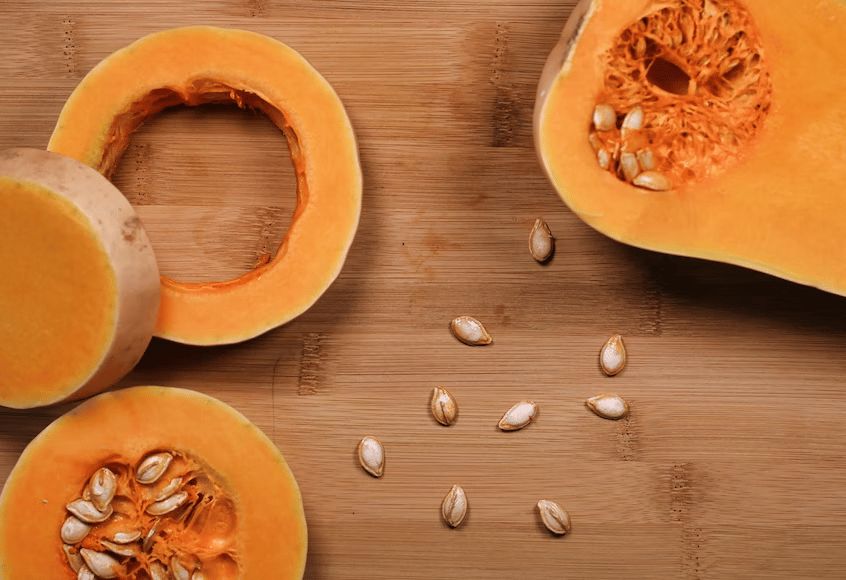
As we all know, cucurbita moschata plays a significant role in crisp autumn to compliment your soups, sauces, and stews. And, you don’t want to ruin all this experience by picking up the wrong bell-shaped squash that won’t meet the standards of perfection!
1 – Check the skin color
Examining the skin or peel color of this could be your primary analysis factor in determining whether it’s a good choice or not. So, the color should be dark beige, and deeper in hue. In contrast, a partially ripened bell-shaped cucurbit indicates green streaks or spots. However, buying one with pale spots is okay, as they are right!
2 – Check the weight
Consider holding it in your hand to analyze its weight. Fully ripe butternut cucurbit should be heavy in weight and firm. You can also pick up other bell-shaped squash lying there to get an idea of the average weight.
If it is too light it is not cooked enough. You can also check this with a knock test; If it sounds hollow, it’s best to go with it!
3 – Inspect the stem
You could say that the stem is another major contributor to the overall health of your bell-shaped squash. Going with a strong and intact stem is ideal as this will help your This winter cucurbit keep longer than cucurbita moschata with a missing stem or a light stem.
4 – Stay away from blemishes
You need to avoid winter squash with soft spots or severe cuts. These are the signs that your cucurbita moschata will rot or mold. However, the cucurbit is probably delicate if there are light surface scratches or blemishes over its outer shell.
5 – Check the skin texture too!
Perfect cucurbita moschata should not be waxy or shiny as if it comes straight from a salon. Besides, you should always go for a natural look, a matte finish in a color that surfaced evenly across the cucurbit.
You can also check the thickness of the outer peel by pricking its surface a little using your fingernail. It should be a hard exterior, and your fingernail must not pass easily.
So, that’s all you need to know about picking before knowing how to cook butternut squash. Let’s now transition to some more essential info on how to cut cucurbita moschata, as they could be your go-to guide while knowing how to prepare bell-shaped squash.
How do Cut or Peel Butternut Squash?
Below are the steps for seeding, peeling, and cutting this winter squash.
Step 1: Separate the stem and bottom. Just make it appear flat on both ends!
Step 2: Ideally, you can use a vegetable peeler to learn how to peel this.
Note that peeling cucurbita moschata can sometimes be difficult! One way to peel is to cut your cucurbit into small pieces. Another way you can do it is to peel the whole Cucurbita moschata before cutting it in half vertically or horizontally.
Step 3: Take a metal spoon and scoop all the seeds out after you remove all the skin from the cucurbit. Well, it’s up to you to discard the seeds or keep them up for roasting.
Step 4: Now, chop the cucurbit into wedges, slices, or cubes.
These steps can help you better understand how to cut and peel this winter squash.
How To Cook Butternut Squash?
Now, it’s time to finally know how to cook butternut squash and check out different ways on how well we can prepare it! Note that some cucurbita moschata cooking methods don’t even require peeling beforehand.
How To Cook Butternut Squash With Roasting Method?
Roasting is one of the usual methods of cooking butternut squash recipes. Cooking can be done in an oven, where time varies from 25 minutes to 1 hour. Take it with or without the skin to cook in an oven. You can roast it by cutting it in half vertically or having its 1-inch small cubes chopped.
Flavor it with salt and black pepper, then slather it with olive oil. Adding extra veggies like onions, sprouts, or potatoes is optional. Moreover, you can sprinkle brown sugar, nutmeg, ground cinnamon, or drizzle maple syrup over it.
How To Cook Butternut Squash With Steaming?
Other popular methods of cooking cucurbita moschata are roasting and steaming. Both methods work great, especially when you seed, cube, and peel Cucurbita moschata.
Best Three Butternut Squash Recipes
1 – Stuffed Butternut Squash
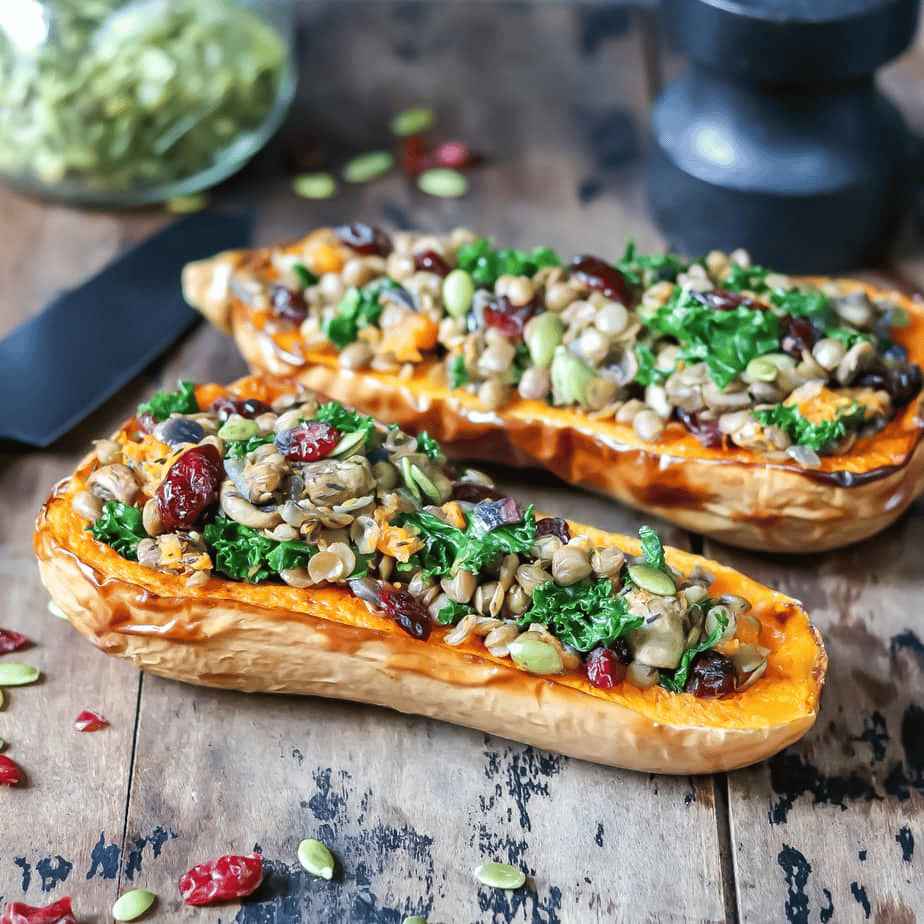
Image Source: Veggie Desserts
Ingredients
- One vegetable stock cube
- 150g pearl barley
- 25g flaked almonds
- 25g pine nuts
- 2 tsp coriander seeds
- 1 tsp fennel seeds
- 3 tbsp rapeseed or olive oil with a drizzle
- One large cucurbita moschata
- One finely chopped red onion
- 200g crumbled feta cheese
- One finely chopped leek
- 2 finely chopped garlic cloves
- Few rosemary springs
- Small bunch of sage
- One zested lemon
- 50g dried apricots or cranberries
Ingredients for the tahini sauce
- 1 juiced lemon
- 2 tbsp tahini
- 1 tbsp honey
- Small bunch of chopped parsley
Cooking Steps
1: Take pearl barley and cook it following the instructions written in the pack. For extra flavor, boil the crumbled stock cubes, drain and set aside to let them cool down.
2: Meanwhile, toast the almonds and pine nuts in a dry pan until nutty brown. You can use the same dry pan to toast the coriander and fennel seeds until they spread a sweet aroma. Then, grind all these spices in a mixer.
3: Cut the cucurbit halfway and scoop out its seeds. You may need to use a scraper to create a center between the cucurbita for stuffing. Firstly, you need to score the flesh with a knife just in case it’s firm.
Then, use the criss-cross pattern to score the flesh out of the two cut cucurbits. Try not to pierce the skin; rub it, and season well with 1 tbsp oil.
4: Heat oven to 180C/160C fan/gas 4. Now, take a pan and heat 2 tbsp oil to cook onion, leek, and chopped cucurbit for at least 8-10 minutes until soft. Stir with garlic and cook for another minute.
The next step is to add nuts, pearl barley, spices, feta, dried fruit, herbs, and lemon zest. Season well and cook for more than 2 minutes at least. Pour this filling into cavities of 2 half squashes. Tie these two half cucurbita with a kitchen string tightly. Make sure to rub the outer portion of the cucurbita a little and wrap it well in foil afterward.
5: Place it in a roasting tin lined with parchment or oil and cook for about 1 hour. To check if the cucurbita is cooked properly, insert the knife or little stick within, and it should come out clean. After it’s cooked, mix the lemon juice, tahini, honey, and a drizzle of water to make a dressing over it.
Cut the cucurbita into slices and serve hot with tahini sauce spread well with parsley.
2 – Pineapple Curry & Thai Squash
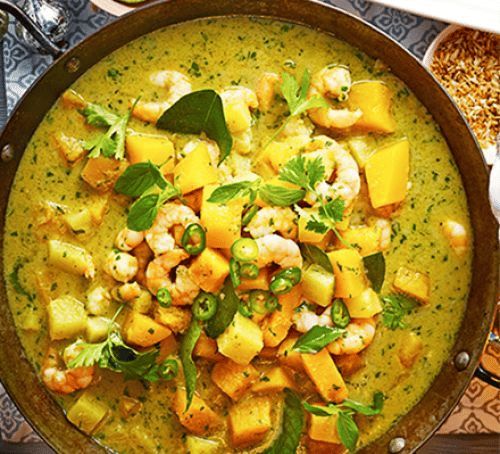
Image Source: Pinterest
Ingredients
- 1 chopped onion
- 1 tbsp sunflower or vegetable oil
- 4 tsp red Thai curry paste
- 200ml vegetable stock
- 14 fl oz reduced-fat coconut milk
- Medium Cucurbita moschata
- 237g pineapple chunks in drained natural juice
- 140g frozen green beans
- Chopped coriander leaves for garnishing
Cooking Steps
Step 1: Take a pan and heat oil to fry onions until soft. Then, add red curry paste, and stir it. Now, add the squash, vegetable stock, and coconut milk. Simmer them for about 15 minutes until the squash gets soft. And tip in the green beans after 10 mins of cooking.
Step 2: Stir in the coriander seeds and pineapple to cook for a few minutes. Serve this curry hot in bowls with rice or noodles and garnish with coriander leaves on the top.
3 – Spinach Lasagne & Caramelized Squash
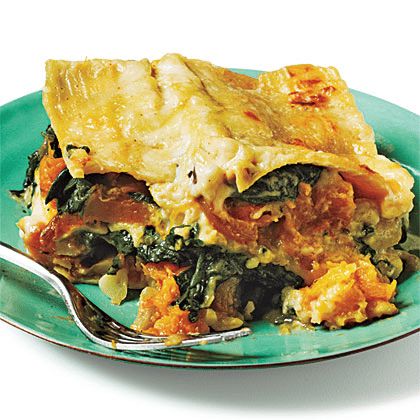
Image Source: MyRecipes
Ingredients
- 3 unpeeled garlic cloves
- 1 medium Cucurbita moschata
- 1 tbsp olive oil
- A handful of sage leaves
- 12-15 lasagne sheets
- 600g fresh spinach
- 40g pine nuts
- 125g ball of mozzarella
Ingredients for the white sauce
- 70g flour
- 70g butter
- 800ml milk
- Granting with nutmegs
- 250g mascarpone
- 50g parmesan, grated
Cooking Steps
1: Heat the oven to about 180C. Then, tip the garlic and cucurbita into a dish or roasting tin, take 4-5 sage leaves, season well, and drizzle with the oil. Move the cucurbita around almost twice while roasting for about 40-50 minutes, and let it be until it is caramelized and soft. Mash the peeled garlic and cucurbita together while leaving some texture with chunky bits.
2: Prepare the white sauce meanwhile. Take a saucepan, melt a large cube of butter, and add the flour to stir till a sandy paste. Stir continuously to avoid lumps and splash little milk as well in between. Keep adding milk in little quantities while the paste gives you a smooth, creamy texture.
Simmer for one more minute. Stir in half the parmesan and mascarpone. Grate some nutmeg for garnishing and season well.
3: Grind the spinach into a mixture. Make sure to do this grinding in small batches while adding water throughout. After it’s done, squeeze it to remove the water and chop it well for seasoning.
4: Take half the crushed garlic and cucurbita from the roasting tin onto a plate. And spread the remaining batter over the base of the roasting tin to serve in the lasagne.
Ladle over around a quarter of the sauce, and create a single layer of lasagne sheets while snapping them to fill excess gaps. Then, layer up beautifully with pasta, spinach, a quarter spoonful of sauce, more pasta, and finally, the remaining white sauce.
5: Scatter the remaining mozzarella, parmesan, and pine nuts. Heat the oven to 180C if it’s already off, and cook the lasagne for about 30 minutes. Take 4-5 sage leaves, rub them with extra oil, and let them sit on top of the lasagne.
Return to the oven to cook for another 15-20 minutes until it spreads bubbles and shows golden. And it’s ready to serve afterward!
Final Words
So this is a complete rundown of how to cook butternut squash, giving you the basics from its health benefits to how to choose the right cucurbita to knowing the best three butternut squash recipes. For more information, it is ideal to also check out the FAQ section below!
FAQs
Q. Before cooking cucurbita moschata, is it necessary to peel it?
Ans. Yes, it’s a good idea to peel the bell-shaped squash before putting it in the oven. Explore the related sections above to learn how to peel cucurbita moschata.
Q. What is the best cooking method for squash?
Ans. Most commonly, there are two cooking methods for cucurbita. So, you can cook it either via roasting or steaming.
Q. What do you eat butternut squash with?
Ans. It goes well with various spices and herbs, as mentioned in the recipes above. Also, it’s good to savor with bacon, chicken, maple syrup, ham, turkey, pasta, nuts, eggs, rice, and sausage.
Q. Is butternut good for weight loss?
Ans. It is rich in fiber and low in calories, making it a healthy option for your weight loss diet plan.
Q. Does butternut squash make you gassy?
Ans. Well, it depends on how much of it you consume. Increasing your consumption of dietary fiber with foods like winter squash can prevent digestive problems like diarrhea, flatulence, bloating, and stomach cramps.

